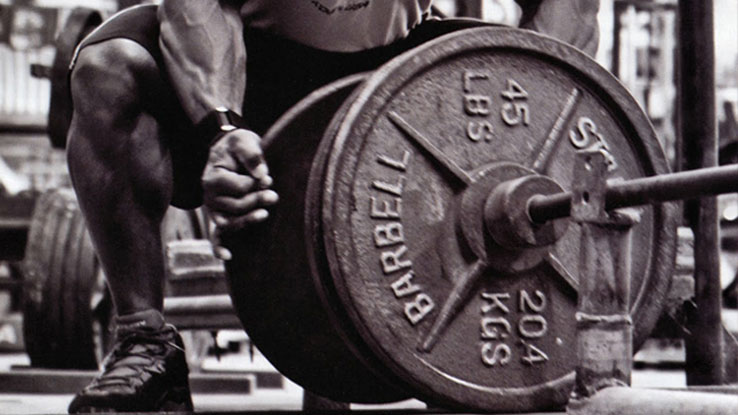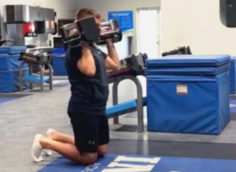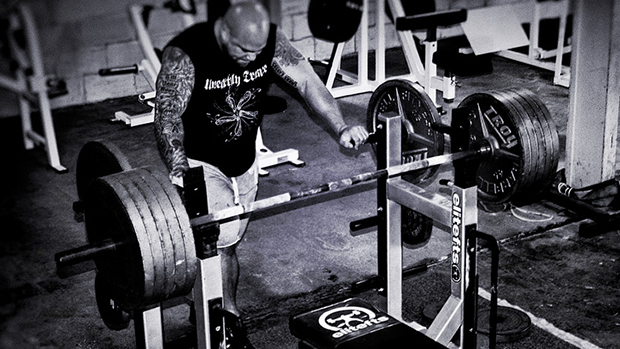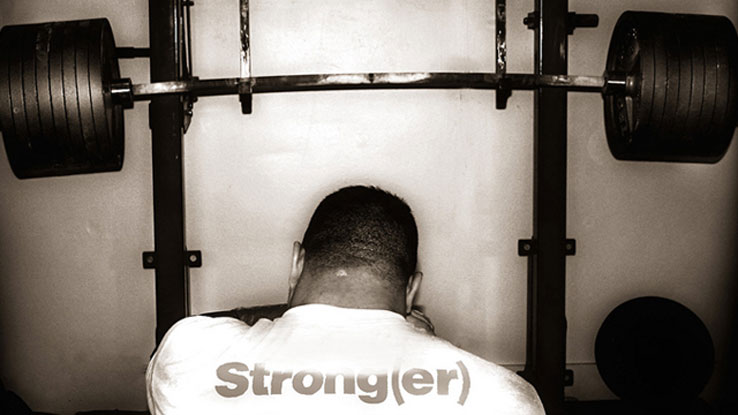In My Favorite Upper Body Warm-up, I presented a simple, effective way to get ready for an upper body workout. Here's the accompanying warm-up for the lower body.
Most lifters find their lower body needs a bit more coaxing than their upper body. Mobility issues tend to appear more with lower body exercises and the weight being lifted is usually greater.
Everyone has their own specific needs, and this warm-up will address the most common issues lifters tend to have, including my own. Feel free to add or remove drills to suit your purposes.
One thing I like about this warm-up is that it takes about 15 minutes to complete – which happens to be about the right amount of time for most to clear their mind of the day's events and get ready to hit the iron. I'm not a fan of 45-minute warm-ups that wear you out by the time a bar is finally on your back.
Another benefit I've found is that the more I do this warm-up, the less I seem to need it, which is a good thing. The goal should be to gradually minimize the warm-up, perhaps even eliminate it entirely (wishful thinking, I admit) because that would mean your body is "ready for action" at all times. If you need a full hour of intense stretching before feeling capable of sitting down into a full squat, let's just say you've got some issues.
1 – Foam Roller
The lower body warm-up starts on the foam roller. The main areas I roll are the quads, IT band, piriformis, and calves. These areas are notoriously tight for most people.
The purpose of the foam roller is to inhibit overactive muscles and prevent them from "getting in the way" when they aren't supposed to be involved in the movement.
Early foam rolling prescriptions called for rolling a muscle's full length 10-20 times at a brisk pace, and then performing a bunch of mini rolls over the target area. Recently, some have suggested rolling the muscle much slower, about one-inch per second, and if a trigger point is hit (a very painful spot in the muscle) just sitting on that spot for 30-45 seconds until the pain lessens or dissipates.
The argument in favor of this new method is that it's more effective as the quicker rolls might actually activate the muscle as opposed to inhibit it. I've used both and focusing on going slow and making sure the muscle is relaxed (allowing the foam roller to get in deep) is definitely more effective.
Some advocate progressing to very hard foam rolling implements – not a bad idea, but let your current implement do its work before moving on. I'm used to foam rolling and a basic foam roller still seems to do the job if I relax the muscle and go slow.
Recap: Foam roll the following areas, 2-3 passes each for 30-60 seconds total time. Sit on trigger points without significant movement.
- Quads
- IT band (both)
- Piriformis (both)
- Calves (feet neutral and externally rotated to hit the lateral calf)
2 – Stretch the Calves
The calves are often very tight in lifters. In a squat or similar motion, this can result in the heels coming up, the feet rotating out when descending, or the person being forced to lean excessively forward to keep the bar over the foot.
Since the foam roller has now opened up the calves, we're ready to stretch them. Use whatever stretch you want – having a bent knee focuses on the soleus, a straight leg hits the gastroc more. A fellow trainer showed me the calf stretch I'm demonstrating in the video. It looks quite simple but I was pleased with how the tweaks he suggested made a big difference. Stretch each calf for 30-60 seconds.
3 – Stretch the Hip Flexors
Hip flexors are another group that tend to get tight, most likely because most of us spend hours a day in a seated position where they're shortened. Tight hip flexors might also inhibit the glutes, a muscle group that most folks already have a hard time recruiting.
The hip flexor stretch I suggest is the classic "prop your back foot up on something, descend as though you were doing a lunge until your knee hits the floor, and stretch."
I like to do this stretch in two phases. In the first phase, bend forward with your hands on the floor. This reduces the stretch on the psoas but hits the iliacus of the back leg and gives a good stretch in the lead leg.
Perform this stretch for about 30 seconds, then lean your torso up and backward while trying to keep the pelvis and back leg in a similar position. This hits the psoas more and involves the rectus femoris as well.
If you want to hit the quad more then focus on getting your butt to your heel; to hit the hip flexors more focus on pushing your pelvis to the floor while keeping your trunk vertical or slightly reclined backwards. Raising your arms above your head, particularly raising the arm of the down leg, helps pull on the fascia and provides a better stretch.
People often feel a bit wobbly in this stretch. Feeling like you're going to fall over or fighting for your balance is not a good thing when stretching – this will activate the muscle spindles and other proprioceptors which can turn a muscle on, something you don't want when stretching. When the body is stable the muscle will relax and a deeper stretch can be achieved.
For this stretch in particular don't be afraid to put something solid in front of you to help with balance and stability. You'll immediately notice improved flexibility once you add to your stability.
4 – Activate the Abductors
It's not uncommon for lifters to have dormant abductor muscles, namely the glute medius and minimus. These muscles help stabilize the leg and knee during both bilateral and unilateral movements. They can also be quite weak and undertrained in lifters that never perform any direct work for them.
I like X-band walks or penguin walks to help wake these muscles up. In X band walks a band is held in the hands to form an X; in penguin walks the band is wrapped around the feet or ankles and not held in the hands. Either is fine.
You don't have to be anal about the workload here – just grab a band and do enough work to feel those muscles working. I use a mini or light band and find that 25 steps up, 25 steps backward (walking backward is actually harder) for a total of two trips in each direction without rest is enough to get a burning feeling.
The key on these walks is to keep your feet hip-width or wider, toes straight ahead, and focus on maintaining the distance between your feet as you walk. Don't worry about taking big steps or going fast.
You will look a little goofy doing these, but it's still cooler than being caught doing the abductor machine (although some women might see that and think you're sensitive).
5 – Lift Specific Stretch
I like to finish the warm-up by performing the lift I'm going to do, or something extremely close to it, as a stretch. For me this usually means a squat or a front squat. I've been doing a lot of front squats lately so I usually grab a shorter bar (25 pounds is the one I use) and do 5 or 6 slow front squats using that extra weight as a stretch. For the last rep I simply sit in the bottom position for 20-30 seconds and let the weight help me stretch.
The neat thing about this stretch is that you can use a variety of progressions based on where you or your clients might be. The most basic and user friendly version is to squat while holding a light weight, say 5-10 pounds, out in front of you with the arms extended straight. This lets the lifter maintain the center of gravity but still sit back into proper squatting position. This technique also works well to teach the squat. Allow me to name it: the straight-arm goblet squat.
From here a dumbbell goblet squat (dumbbell held vertically against the chest) works great. You can go a bit heavier with this goblet squat versus the previous version because the weight is held against the body and not straight out in front of you.
Next up is a basic front squat with the bar held in rack position works well. The bar doesn't have to be held in perfect rack position – just hold it as best you can.
The next progression is to perform a back squat with a light weight. It's harder to maintain proper form with a super light weight in a back squat versus a front squat, which is why the back squat is the next step in the mobility progression.
Finally, do an overhead squat. While you don't have to have perfect form, this will most directly target both upper and lower body mobility. You might complete 5 reps of a front squat (or back squat, your preference) and then go directly into 5 reps of an overhead squat, using the weight to stretch you out.
Another option is to perform an overhead squat immediately after the goblet squat by holding the dumbbell above your head. The dumbbell is easier to hold than the barbell but since your hands are together it makes for an interesting challenge. The video below shows a demonstration of the front squat to overhead squat.
To recap, pick one of these options (don't do them all) and do 5-6 reps with a pause on the last one to get a good stretch. Over time, if an exercise becomes easy, feel free to progress to the next level.
The point of this warm-up is to prepare you for strength-based barbell exercises. You may find that you want to add in or substitute some stuff to help with your specific issues.
Substitutes
Listed below are some substitutes that you might consider using:
- Roll the bottom of your feet. Loosening up the fascia on the bottom of the foot can help the entire body feel more limber. Take off your shoes and roll your feet on a tennis or lacrosse ball for 30-60 seconds per foot.
- Activate the glutes. If you don't think your glutes are contracting the way they should during an exercise, try activating them with hip thrusts. For the hip thrusts, just do 1 or 2 sets with no or light weight and focus on the full ROM and feeling the glutes working.
- Shoulder dislocations. This isn't so much for the lower body but if you have trouble putting the bar on your back to squat, you might want to try doing 10-20 shoulder dislocations with a PVC pipe or broomstick. Bill Starr swears by these and I've added them into my upper body warm-up routine as well.
- Low box jumps. If your workout is going to be more power and speed-based or you're hoping to activate the type IIB(x) motor units, a few box jumps can help prime everything. Two to three sets of 3-5 reps seems to work well – it's okay to start on a low box if necessary; remember, this is ultimately a warm-up.
- Sled drag. Dragging a sled can be an effective warm-up for the lower body. Generally, walking forward with the sled behind you focuses more on the glutes and hamstrings, walking backward facing the sled hits more quads, and walking sideways hits more abductors. Feel free to get creative with it. For more information see my article about how to build and use a sled.
Warmed Up!
I like to say you can't argue with results, so trust how you feel, and most importantly, how you perform once you're warmed up. Be wary of setting up a complex warm-up routine that takes 45 minutes to complete and leaves you gassed at the end of it.
If you don't need much of a warm-up to squat heavy, consider yourself lucky; but keep an eye out for any compensations that might develop down the line. There's a reason most serious lifters over 30 spend some time each day getting their body ready to lift weights. Warming up is important stuff, but it doesn't have to be complicated!





